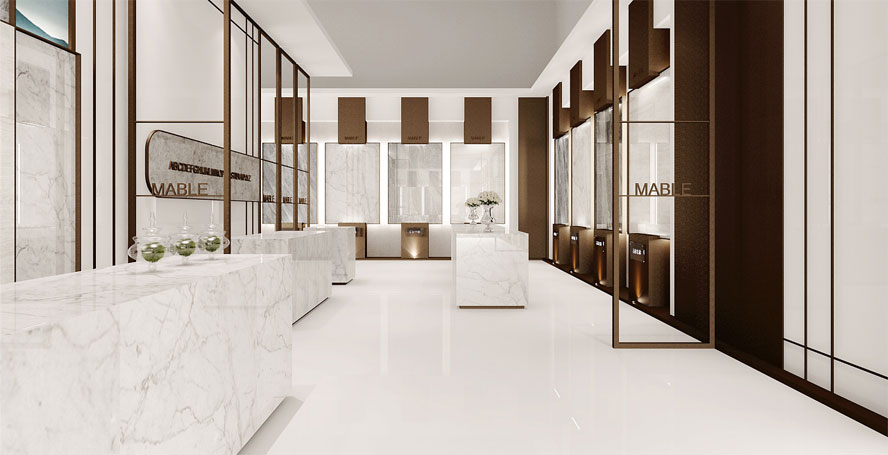This residence in Deer Valley, Utah, was built with quartzite stones. The material helps the house blend in to its environment, while providing an exterior surface that will last for decades.
Quartzite is a metamorphic rock that began its geological life as sandstone. Through pressure and time, the individual quartz grains in the sandstone recrystalized along with the former cementing material to form an intermingling mosaic of quartz crystals. This process results in a glassy luster that lends to the stone's popularity. Typically, pure quartzite ? composed of sandstone and silicate minerals, such as mica ? displays understated tones of whites, grays or pinks. However, when small amounts of other minerals are involved in the metamorphic process ? as is usually the case ? quartzite will take on a diverse series of colors.
Quartzite can be found throughout the world, and it is used extensively in the United States and Europe. Known as a hard, resilient stone that is resistant to chemical weathering, quartzite is used widely in the flooring industry to produce both indoor and outdoor tiles. Additionally, pure quartzite provides a source of silica for metallurgical purposes and for the manufacture of brick. This stone also is used for paving blocks, riprap and roofing granules, among other uses.
Europe, Africa, South America, India and China are primary international sources.
The quarries for quartzite tend to be relatively shallow because the silica content of the rock prevents much soil from forming, leaving the smooth stone either bare or covered by just a thin layer of vegetation. Thus, the stone typically is acquired through surface mining. The stone is extracted by first removing any overburden from above the stone, and it is then removed using large excavators. On occasion, some carefully placed explosives may be required to loosen this resilient stone.
Feathers and wedges for plugging and drilling are used for breaking larger blocks into thin slabs.Miners will tap each wedge and continue down the stone until it begins to separate.Then,the feathers and wedges are removed,and a pry bar is used to finish separating the slab from the rest of the stone.Any further splitting or fabrication of the stone is typically handled by machines.
Industry experts say that fabrication of quartzite has been slow to develop because of the stone's hardness and mica content. This process is still limited to a handful of companies that have the necessary high-tech equipment to service customers and dealers. However, demand for the stone is growing with some distributors claiming that it is double the supply.
Most often, quartzite is found in shades of milky white, thundercloud gray, sunset gold or muted brown, but it is sometimes colored medium blue, lime green or black by included minerals. These more sedate, neutral colors mean that quartzite can be blended easily into any type of design scheme, in both warm and cool climates. For more playful or boisterous applications, consider Minnesota Sioux quartzites. In Minnesota, trace amounts of hematite, an oxide of iron, permeates the rock, giving it an amethyst hue of purple to pink.
Further, because of the stone's mica content (or other silicate minerals), quartzite often shimmers with a subtle hint of sparkle, which makes the stone a perfect complement to other natural materials, as well as chrome, steel and other metal surfaces and fittings.
Quartzite features a natural ability to split along foliations, making it suitable for wall cladding and roofing tiles. Further, its granoblastic, medium-grained texture permits quartzite to be used in flooring applications and all other interior or exterior tile designs. Quartzite distributors say the stone is a perfect choice for pool decks, entrance ways, stair treads and other areas where foot traffic may be heavy because the building material is easy to clean and provides a natural non-skid surface. In fact, the stone is so durable that it can be exposed to harsh traffic and heavy weather conditions without worry.
One example in the United States of how a community has made extensive use of its local quartzite resources is Lehigh University in Bethlehem, Pa. According to the university, the local Hardyston quarries have provided building blocks for many campus facilities, as well as for nearby churches. For instance, the Linderman Library, originally constructed in 1877, is comprised largely of the local Hardyston quartzite with a limestone trim.

Add:Add:NO.78 BIYUN ZHONG LU,HONGTANG TOWN,TONG'AN DISTRICT,XIAMEN,CHINA
Tel:86-592-2219816/2225286
Fax:86-592-2222216
E-mail:stone@ninesun-stone.com sales@ninesun-stone.com